Bird of Paradise
Strelitzia nicolai, also known as Wild Banana and Giant White Bird of Paradise.
| Pot Size | 06", 10" |
|---|
Category: Strelitzia NicolaiTags: Bird, Bird of Paradise, Paradise
Prices are subject to change without notice.
Please see our latest availability for current pricing.
Description
This beauty is a species of banana-like plants with erect woody stems reaching a height of 7–8 m, and the clumps formed can spread as far as 3.5 m. The 1.8 m-long leaves are grey-green and arranged like a fan at the top of the stems. The inflorescence is composed of a dark blue bract, white and orange sepals and a bluish-purple “tongue”.
It grows particularly well in nearly all of Florida, and along the Gulf of Mexico, also in the coastal areas of Texas, Louisiana and California. ~{Wikipedia}
Views: 57
Care Instructions
Light Exposure
Watering
Fertilizing
Dimensions
Other
Strelitzia Nicolai does best in bright, indirect light. Indoors, put it near a window that gets good light through the day. It can stand some direct sunlight, especially during the later hours of the afternoon to evening, but too much direct sunlight can burn its leaves. A room with east or west-facing windows is best. Outdoors they prefer some partial sun and shade.
This plant enjoys consistently moist soil but does not like to sit in water. Water the plant thoroughly, allowing excess water to drain out, but ensure the soil dries out slightly between waterings. In a pot, use a high quality potting mix with sand and maybe some hummus added for better drainage. It is important that the roots do not remain too wet. Outdoors add some compost to the soil before planting.
Water more frequently during spring and summer, usually once a week or when the top of the soil feels dry. The plant will not require this during the winter.
Use a good quality soluble liquid fertilizer or slow release pellets. Feed the plant about every two weeks during the spring through summer. You should not need to do this during the winter.
These plants ca be around for years indoors, and can reach up to 10' indoors, with a spread of iup to 3'. Outdoors they can grow to 30' (Zones 10-12)
These plants are known to be toxic to animals. NOTE: Getting these plants to flower requires a bit of upkeep, being diligent with light, water and fertilizer, and you can be rewarded with their beautiful blooms!

